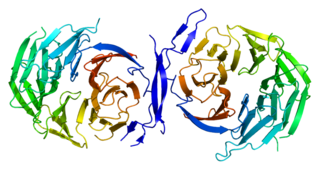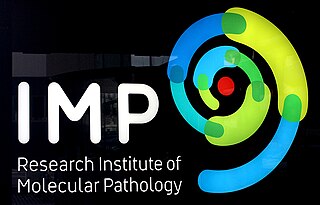Related Research Articles

Haematopoiesis is the formation of blood cellular components. All cellular blood components are derived from haematopoietic stem cells. In a healthy adult human, roughly ten billion to a hundred billion new blood cells are produced per day, in order to maintain steady state levels in the peripheral circulation.

In molecular biology, a transcription factor (TF) is a protein that controls the rate of transcription of genetic information from DNA to messenger RNA, by binding to a specific DNA sequence. The function of TFs is to regulate—turn on and off—genes in order to make sure that they are expressed in the desired cells at the right time and in the right amount throughout the life of the cell and the organism. Groups of TFs function in a coordinated fashion to direct cell division, cell growth, and cell death throughout life; cell migration and organization during embryonic development; and intermittently in response to signals from outside the cell, such as a hormone. There are approximately 1600 TFs in the human genome. Transcription factors are members of the proteome as well as regulome.

A homeobox is a DNA sequence, around 180 base pairs long, that regulates large-scale anatomical features in the early stages of embryonic development. Mutations in a homeobox may change large-scale anatomical features of the full-grown organism.

In evolutionary developmental biology, Paired box (Pax) genes are a family of genes coding for tissue specific transcription factors containing an N-terminal paired domain and usually a partial, or in the case of four family members, a complete homeodomain to the C-terminus. An octapeptide as well as a Pro-Ser-Thr-rich C terminus may also be present. Pax proteins are important in early animal development for the specification of specific tissues, as well as during epimorphic limb regeneration in animals capable of such.

Paired box protein Pax-6, also known as aniridia type II protein (AN2) or oculorhombin, is a protein that in humans is encoded by the PAX6 gene.

The PAX3 gene encodes a member of the paired box or PAX family of transcription factors. The PAX family consists of nine human (PAX1-PAX9) and nine mouse (Pax1-Pax9) members arranged into four subfamilies. Human PAX3 and mouse Pax3 are present in a subfamily along with the highly homologous human PAX7 and mouse Pax7 genes. The human PAX3 gene is located in the 2q36.1 chromosomal region, and contains 10 exons within a 100 kb region.

Microphthalmia-associated transcription factor also known as class E basic helix-loop-helix protein 32 or bHLHe32 is a protein that in humans is encoded by the MITF gene.

B-lymphocyte antigen CD19, also known as CD19 molecule, B-Lymphocyte Surface Antigen B4, T-Cell Surface Antigen Leu-12 and CVID3 is a transmembrane protein that in humans is encoded by the gene CD19. In humans, CD19 is expressed in all B lineage cells. Contrary to some early doubts, human plasma cells do express CD19. CD19 plays two major roles in human B cells: on the one hand, it acts as an adaptor protein to recruit cytoplasmic signaling proteins to the membrane; on the other, it works within the CD19/CD21 complex to decrease the threshold for B cell receptor signaling pathways. Due to its presence on all B cells, it is a biomarker for B lymphocyte development, lymphoma diagnosis and can be utilized as a target for leukemia immunotherapies.

Paired box gene 2, also known as Pax-2, is a protein which in humans is encoded by the PAX2 gene.

Paired box gene 8, also known as PAX8, is a protein which in humans is encoded by the PAX8 gene.

Paired box protein Pax-5 is a protein that in humans is encoded by the PAX5 gene.

Paired box gene 4, also known as PAX4, is a protein which in humans is encoded by the PAX4 gene.

Paired box protein Pax-7 is a protein that in humans is encoded by the PAX7 gene.

Transcription factor COE1 is a protein that in humans is encoded by the EBF1 gene. EBF1 stands for Early B-Cell Factor 1.

Paired-like homeodomain 1 is a protein that in humans is encoded by the PITX1 gene.

Transducin-like enhancer protein 4 is a protein that in humans is encoded by the TLE4 gene.

The Research Institute of Molecular Pathology (IMP) is a biomedical research center, which conducts curiosity-driven basic research in the molecular life sciences.

Myogenic factor 5 is a protein that in humans is encoded by the MYF5 gene. It is a protein with a key role in regulating muscle differentiation or myogenesis, specifically the development of skeletal muscle. Myf5 belongs to a family of proteins known as myogenic regulatory factors (MRFs). These basic helix loop helix transcription factors act sequentially in myogenic differentiation. MRF family members include Myf5, MyoD (Myf3), myogenin, and MRF4 (Myf6). This transcription factor is the earliest of all MRFs to be expressed in the embryo, where it is only markedly expressed for a few days. It functions during that time to commit myogenic precursor cells to become skeletal muscle. In fact, its expression in proliferating myoblasts has led to its classification as a determination factor. Furthermore, Myf5 is a master regulator of muscle development, possessing the ability to induce a muscle phenotype upon its forced expression in fibroblastic cells.
Margaret Buckingham, is a British developmental biologist working in the fields of myogenesis and cardiogenesis. She is an honorary professor at the Pasteur Institute in Paris and emeritus director in the Centre national de la recherche scientifique (CNRS). She is a member of the European Molecular Biology Organization, the Academia Europaea and the French Academy of Sciences.
Alexander Stark is a biochemist and computational biologist working on the regulation of gene expression in development. He is a senior scientist at the Research Institute of Molecular Pathology (IMP) at the Vienna Biocenter and adjunct professor of the Medical University of Vienna.
References
- ↑ "Meinrad Busslinger's lab at the IMP" . Retrieved 2019-01-08.
- ↑ "Curriculum Vitae – Meinrad Busslinger" (PDF). Retrieved 2019-01-08.
- ↑ "Curriculum Vitae – Meinrad Busslinger" (PDF). Retrieved 2019-01-08.
- ↑ "Developmental and tissue-specific regulation of a novel transcription factor of the sea urchin" . Retrieved 2019-01-08.
- ↑ Czerny, Thomas; Bouchard, Maxime; Kozmik, Zbynek; Busslinger, Meinrad (1997). "The characterization of novel Pax genes of the sea urchin and Drosophila reveal an ancient evolutionary origin of the Pax2/5/8 subfamily". Mechanisms of Development. 67 (2): 179–192. doi:10.1016/S0925-4773(97)00119-6. PMID 9392515. S2CID 14803680.
- ↑ "IMP Management" . Retrieved 2019-01-08.
- ↑ "Pax-5 encodes the transcription factor BSAP and is expressed in B lymphocytes, the developing CNS, and adult testis" . Retrieved 2019-01-08.
- ↑ "Commitment to the B-lymphoid lineage depends on the transcription factor Pax5. Nature. 1999. 401: 556–562" . Retrieved 2019-01-08.
- ↑ "Pax5/BSAP Maintains the Identity of B Cells in Late B Lymphopoiesis" . Retrieved 2019-01-08.
- ↑ "Molecular role of the PAX5‐ETV6 oncoprotein in promoting B‐cell acute lymphoblastic leukemia" . Retrieved 2019-01-08.
- ↑ "Molecular functions of the transcription factors E2A and E2-2 in controlling germinal center B cell and plasma cell development" . Retrieved 2019-01-08.
- ↑ "Essential role of EBF1 in the generation and function of distinct mature B cell types" . Retrieved 2019-01-08.
- ↑ "Pax5 induces V-to-DJ rearrangements and locus contraction of the immunoglobulin heavy-chain gene" . Retrieved 2019-01-08.
- ↑ "Flexible Long-Range Loops in the VH Gene Region of the Igh Locus Facilitate the Generation of a Diverse Antibody Repertoire" . Retrieved 2019-01-08.
- ↑ "EMBO member database" . Retrieved 2019-01-08.
- ↑ "Member profile Academia Europaea" . Retrieved 2019-01-08.
- ↑ "START- und Wittgenstein-Preise 2001 verliehen (news report in German)" . Retrieved 2019-01-08.
- ↑ "Member directory, Austrian Academy of Sciences" . Retrieved 2019-01-08.
- ↑ "ERC Grant data base" . Retrieved 2019-01-08.
- ↑ "Meeting Report, European Journal of Immunology" . Retrieved 2019-01-08.
- ↑ "ERC Grant data base" . Retrieved 2019-01-08.
- ↑ "Zwei hochdotierte EU-Förderpreise für IMP-Forscher (German)" . Retrieved 2019-01-08.
- ↑ "Preis der Stadt Wien" . Retrieved 2021-07-15.